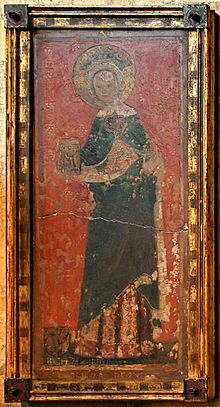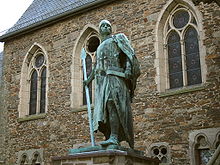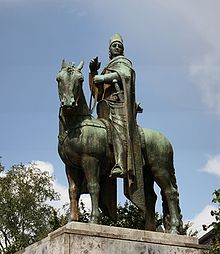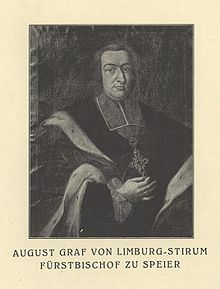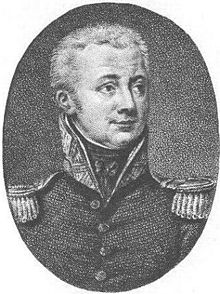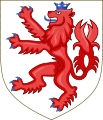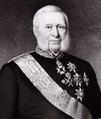- House of Limburg-Stirum
-
The house of Limburg-Stirum, which adopted its name in the 12th century from the castle of Limburg an der Lenne in what is now Germany, descends from the Ezzonen dynasty in the 9th century, making it one of the oldest families in Europe.
The Limburg-Stirum were sovereign monarchs in the Holy Roman Empire. They were mediatised in 1806 by the Confederation of the Rhine. They mistakenly often don't appear in the section of sovereign houses of the Almanach of Gotha, because the two youngest branches of the family became extinct in the beginning of the 19th century.
Since the 9th century, the family counted five Counts Palatine of Lotharingia, several Dukes of Westphalia, Bavaria, Carinthia and Swabia, seven Archbishops of Cologne, one Prince-Bishop of Speyer, more than ten Bishops in the Holy Roman Empire, and at least two Saints of the Catholic Church (Saint Richenza, celebrated on 21 March, and Saint Engelbert of Cologne, celebrated on 7 November).
The territorial authority of the family, counts of Berg since 1077, then counts of Limburg since 1246, was significantly reduced following the opposition of Frederick II, Count of Isenberg to the aggressive power politics of his cousin, the Archbishop of Cologne, Engelbert II of Berg, leading to the murder of the latter. A junior line, the Counts von der Marck, later rose in importance as dukes of Cleves, Jülich and Berg, dukes of Nevers and Bouillon, counts von Schleiden, etc.
Today's members are mostly found in Belgium and The Netherlands.
Contents
History
 The Ezzonian Dynasty
The Ezzonian DynastyThe Ezzonen appear in the chronicles with Erenfried I (866-904), count of the Bliesgau, Keldachgau and Bonngau (maybe also count of Charmois). Probably he had Carolingian ancestors, although same historians prefer to link him to former Thuringian kings.
The Ezzonian dynasty (named after count palatine Ezzo) were the Counts Palatine of Lotharingia during the 10th and 11th century. They are considered to be the most important royal representatives in the region of the Middle and Lower Rhine. In spite of their military accomplishments in favour of the German emperors, the Ezzonians did not succeed in building a territorial entity in Lotharingia. During a limited period, they were assigned however the duchies of Swabia, Bavaria and Carinthia.
Famous members of the dynasty are:
- Ezzo, Count Palatine of Lotharingia (1015–1034). According to the Brauweiler chronicle, he failed to succeed in the monarchy after the death of emperor Otto III (983–1002) in a rivalry with duke Heinrich II of Bavaria (1002–1024). The succession war between Ezzo and Heinrich II continued for over ten years. Both parties came to an agreement after a battle in Odernheim (1011). Kaiserswerth, Duisburg and the surrounding imperial territories were granted as a fief to Ezzo for renouncing the throne (after 1016). When the German crown passed from the Ottonian to the Salian (1024), the Ezzonen remained neutral, apparently after an agreement between Ezzo and Konrad II (1024–1039). The Annales Hildesheimenses record that "Hezo Palatinus comes" died after catching pox from his concubine.
- Otto I, Count Palatine of Lotharingia (1035–1045) and Duke of Swabia (1045–1047). After a successful campaign against the rebelling count of Flanders (margrave of Valenciennes and Ename) Otto received the duchy of Swabia in 1045, in exchange however for the cities of Kaiserswerth and Duisburg, which went back to the crown. At the same time, the palatinate of Lotharingia was passed to his nephew.
- Heinrich I Furiosus, Count Palatine of Lotharingia from 1045 until 1060. He was elected as successor for the German kingdom during Emperor Heinrich III's illness. Hearing that his wife Mathilde (daughter of Duke Gozelo of Lotharingia, and sister of pope Stephen IX) had a love-affair with one of his relatives, he killed her with an axe. Heinrich then was enclosed into the abbey of Echternach, where he died in 1061.
- Richeza of Lotharingia, Queen of Poland. Her marriage to Mieszko II was decided as part of peace an agreement between King Bolesław I the Brave and Emperor Otto III. After she returned to Germany after the deposition of her husband in 1031, she became later a nun and today is reverencied as Blessed Richeza of Lotharingia, celebrated on March 21.
- Conrad I, Duke of Bavaria, heir of Henry III, Holy Roman Emperor. He was deprived of the dukedom in 1053 when the Emperor installed his son as Duke. He died in exile after an attempt to assassinate the Emperor and seize the throne.
- Conrad III, was installed as Duke of Carinthia in 1057. The Annales of Berthold record the death in 1061 of Chounradus... Carantanis ducis.
- Hermann I, Archbishop of Cologne, Chancellor of King Zwentibold of Lotharingia.
- Hermann II, Archbishop of Cologne. He became Archchancellor of Italy and protector of Brauweiler (1053). He baptised and crowned the German king Henry IV.
- Hermann II, Count Palatine of Lotharingia (1064–1085), count of the Ruhrgau, Zulpichgau and Brabant. Hermann is assumed to be last of the Ezzonians. After his death (he was killed in a duel with Albert III of Namur, nearby his castle of Dalhem on September 20, 1085) the Palatinate of Lotharingia was suspended. His widow remarried with the first count palatine of the Rhine, Henry of Laach.
The surviving line of the Ezzonen descends from Adolf I of Lotharingia, son of Hermann I "Pusillus", Count palatine of Lotharingia.
 Counts of Berg
Counts of Berg Count Frederick I of Altena purchased Schloss Mark near Hamm from the Edelherren of Rüdenberg and made it the residence of the new Counts of the Mark.
Count Frederick I of Altena purchased Schloss Mark near Hamm from the Edelherren of Rüdenberg and made it the residence of the new Counts of the Mark.
Adolf I of Lotharingia grandson, Adolf I of Berg, Vogt of Werden Abbey, became the first Count of Berg in 1050. The Counts of Berg became the most powerful dynasty in the Rhine region. Early rulers of Berg were:
- Adolf I of Lotharingia, count in Keldachgau, Vogt of Deutz from 1008 until 1018.
- Adolf II of Lotharingia, count in Keldachgau and Vogt of Deutz.
- Adolf I of Berg, 1st Count of Berg from 1077 till 1082, Vogt of Werden, Deutz, Berg and Gerresheim.
- Adolf II of Berg-Hövel (Huvili), Count of Berg from 1082 till 1093. He married in 1035 Adelheid von Laufen, heiress of Hövel, Unna, Telgte, Warendorf, etc. He founded the Altenberg monastery.
- Adolf III, Count of Berg from 1093 till 1132. His son, Eberhard of Berg, 1st Abbot of Georgenthal, convinced his brother Adolf IV to donate the Altenberg monastery to the Cistercian Order. His youngest son, Bruno II, Archbishop of Cologne, died in 1137 in Apulia on campaign with King Lothair of Germany against Roger II of Sicily.
- Adolf IV, Count of Berg from 1132 till 1160 and Count of Altena. He built the Schloss Altena, and built the Altenberg monastery where he enters in 1160. He is father of one crusader (Adolf V, killed in Damascus in 1108), two Archbishops of Cologne and Duke of Westfalia and one Prince Bishop of Osnabrück.
- Engelbert I, Count of Berg from 1160 till 1189. He brought stability and prosperity to the county. In July 1189 he was killed on his way to the Holy Land with the Third Crusade.
- Adolf VI, Count of Berg from 1189 till 1218. In 1212 he took part to the Albigensian Crusade against the Cathars. He died in 1218 in combat as commander of the troops in Damiette, in the delta of the Nile, with the Fifth Crusade. He left no son, and Berg passed under the regency of his brother Engelbert II, then to his daughter Irmgard.
- Engelbert II of Berg, Archbishop of Cologne, Regent of Berg from 1218 till 1225, better known as Saint Engelbert of Cologne. He was killed by his cousin Frederick of Isenberg (see below).
- Irmgard, heiress of Berg until 1248, married to Henry IV Duke of Limburg, and future Count of Berg.
 Counts of Altena and Isenberg
Counts of Altena and IsenbergEberhard IV of Berg, son of Adolf IV of Berg and Altena, inherited the eastern territorium of County of Berg. With him, the oldest line of the Counts of Berg takes from 1166 the name and title of Counts of Altena (on the Lenne, Westphalia). Eberhard's territorium was later divided between his two sons:
- Arnold of Altena, the eldest, inherited the north-western territorium of Altena, and became 1st count of Isenberg (on the Ruhr, Hattingen) in 1200. He founded the line of the Counts of Isenberg and later Counts of Limburg (see below).
- Frederick I, the youngest, inherited the south-eastern territory of Altena, and founded of the line of the Counts von der Marck, from which descend the dukes of Cleves, Jülich and Berg, the dukes of Nevers and Bouillon, the counts von Schleiden, etc.
 The murder: from Isenberg to Limburg
The murder: from Isenberg to LimburgFrederick II, Count of Isenberg was a leading figure in the opposition of Westphalian nobles to the aggressive power politics of his cousin, the Archbishop of Cologne, Engelbert II of Berg. In 1225 at the Nobles' Assembly in Soest, Frederick met his cousin Engelbert von Berg in order to bring about a peaceful agreement concerning the stewardship (Vogtei) of the Abbey of Essen, which Frederick, according to contemporary complaints, was abusing to his own benefit and to the detriment of the Abbey. No conclusion was reached. During their return together from Soest to Cologne, Count Frederick arranged an ambush on his cousin, in a defile at the foot of the Gevelsberg between Hagen and Schwelm in the late afternoon of 7 November 1225: the Archbishop was killed.
There is no consensus as to whether it was a deliberately planned murder, or whether the Archbishop was killed in the heat of combat. Current research assumes the latter: Engelbert was intended to have been taken into "knightly detention" so that the political demands of the opposing nobility could be pushed through. This was in accordance with the customs of the medieval feuding ethos.
Frederick of Isenberg was outlawed and excommunicated. He was stripped of all offices and stewardships and his entire personal wealth was confiscated. In the winter of 1225/1226 the new Archbishop of Cologne, Heinrich von Müllenark, besieged and destroyed his castle. His cousin, Adolf von der Mark, was attributed large portions of Frederick's possessions and as such re-united the former territory of Altena.
Frederick travelled with his brothers Dietrich and Engelbert, bishops of Münster and Osnabrück (both also implicated in the death of the Archbishop), and the notary of Isenberg with the necessary documents to the Curia in Rome, in order to have the excommunication lifted. On the return journey Frederick was taken prisoner at Liège and sold for 2,100 silver marks to the chapter of Cologne cathedral. On 14 November 1226 he was executed in front of the Severin Gate. His arms and legs were smashed and he was broken on the wheel, after which he was displayed on a stone pillar. He did not die until the next day.
His son Count Dietrich I of Isenberg, disinherited of all his territories in the Holy Roman Empire following the execution of his father, later fought with the military support of his uncle the Duke of Limburg, to retrieve his paternal inheritance. On 1 May 1243 a peace agreement was signed between Dietrich and Count Adolf von der Mark. He built the castles of Limburg (Hohenlimburg) and Neu Isenberg (soon lost in favour of the Counts von der Mark) and from 1246 took the title of Count of Limburg. Later, Dietrich's second son Johann gained ownership of Mülheim an der Ruhr and thereby of the castle of Styrum and took up residence there.
 16th to 18th century
16th to 18th centuryCount Georg of Limburg-Styrum married in 1539 Irmgarde of Wisch, Lady of Wisch op Oud-Wisch, Wildenborch, Overhagen and Lichtenvoorde, hereditary countess von Bronckhorst. Finally she inherited the possessions of her uncle, the last count of Bronckhorst and Borculo. Her possessions passed to her son Hermann Georg of Limburg, and the family settled in Gelderland. His grandson, Jobst of Limburg-Styrum, married Maria of Holstein-Pinneberg, heir of the immediate lordship of Gemen and Illereichen. Gemen stayed for two centuries to the Counts of Limburg Stirum.
His son Herman Otto I, count of Limburg and Bronckhorst, sovereign lord zu Gemen, served in the armies of the Dutch Republic. He commanded Christian of Brunswick's rearguard at the Battle of Stadtlohn (1623) and the Dutch cavalry at the Siege of Groenlo (1627). In 1644, the three sons of Herman Otto I divided the family possessions between themselves:
Limburg Bronckhorst
Otto of Limburg obtained the territories of Bronckhorst and Borculo. He founded the older line, still alive today.
In the long conflict (known as the "Borculo question") between the heirs of the last count of Limburg-Bronckhorst, Joost (deceased in 1553 without children), and the Prince-Bishop of Munster over ownership of Borculo, the Court of Gelderland ruled on 20 December 1615 in favour of count Joost van Limburg and Bronkhorst. The ruling was imposed by troops from Zutphen, taking over the castle and city of Lichtenvoorde in December 1615, and the castle and city of Borculo in February 1616 after short combat. Prince Bishop Christoph Bernhard von Galen, tried again twice to keep Borculo under Munster's authority, but without success.
The lordship of Bronckhorst was sold in 1721 by Maria of Limburg Styrum. In 1726 was the lordship of Borculo sold by count Leopold to the count of Flodorf.
Limburg Stirum Gemen
Adolf Ernst of Limburg Stirum obtained the immediate lordship of Gemen and Illereichen in the partition in 1644 and ruled it until his death in 1657. He founded the line of Limburg Stirum Gemen. In 1782, with extinction of Gemen branch of the House of Limburg Stirum, Gemen was inherited by the line of Limburg Stirum Iller-Aicheheim.
-
- 1657-1675 - (Maria) Isabella countess von Vehlen und Meggen zu Raesfeld, wife of Adolf Ernst of Limburg Stirum, was Regent of Gemen after the death of her husband. The reason for the long regency is not known.
- 1675-1704 - Hermann Otto II of Limburg Stirum and Bronckhorst, Sovereign Lord zu Gemen, son of the two above. He fought in the War of the Spanish Succession in the service of the Holy Roman Emperor Leopold I against France and Bavaria. In 1703, he lost the Battle of Höchstädt against the French-Bavarian forces. In 1704, he led the second assault on enemy positions in the Battle of Schellenberg and was mortally wounded. He died a few days later;
- 1704-1743 - Otto Leopold of Limburg Stirum and Bronckhorst, Sovereign lord zu Gemen and Raesfeld, inherited Gemen at the death of his father. He also inherited from his grandfather Alexander IV count von Velen zu Raesfeld the Lordship of Raesfeld;
- 1743-1771 - Friedrich Karl of Limburg Stirum and Bronckhorst, Sovereign lord zu Gemen, son of Otto Leopold. He died in 1771 without descendants and both Gemen and Raesfeld passed to his brother August Philip, Prince-Bishop of Speyer;
- 1771-1776 - August Philip, Prince-Bishop of Speyer, count of Limburg Stirum and Bronckhorst, Sovereign Lord zu Gemen, brother of the above;
- 1776-1798 - Karl Josef, count of Limburg Stirum, Sovereign Lord zu Gemen, cousin of the above;
- 1798-1800 - Ferdinand IV, count of Limburg Stirum zu Illereichen, grandson of the above, was the last Sovereign Lord zu Gemen before it passed to the Barons of Bomelberg in 1800.
In 1806, Gemen was mediatized to the Princes of Salm-Kyrburg. It passed to France in 1810, then to Prussia in 1814.
Limburg Styrum
Moritz of Limburg-Styrum obtained the ownership of Mülheim an der Ruhr and thereby of the immediate lordship of Styrum, and later Oberstein. Here he founded the line of counts of Limburg-Styrum-Styrum, extinct in 1809. Moritz later also became hereditary banneret of the Principality of Guelders and of the County of Zütphen. He married his cousin Maria Bernhardine of Limburg and Bronckhorst.
In the mediatisation of 1806, Styrum came under control of the Grand Duchy of Berg. The last count of Limburg-Styrum-Styrum, Ernst (deceased on 23 March 1809) in his will donated Styrum to the sister of his wife: Maria Margaretha von Humbracht, who sold it in 1825. Oberstein was mediatized at the Treaty of Lunéville in 1801, however Ernst was never compensated by the Final Recess in 1803.
Mediatization
The Limburg Stirum held seats in the Holy Roman Empire's Imperial Diet until 1800, through their possessions of immediate lordships in Gemen, Oberstein, Styrum, etc. When the branch of Gemen became extinct in 1800, the branch of Styrum failed to inherit their rights and possessions, and the sovereignty of Gemen passed to the barons of Boyneburg-Bömelberg.
In 1806 the Confederation of the Rhine occurred and Gemen was mediatized (hence making the barons of Boyneburg-Bömelberg the only barons together with the Bentincks to be mediatized). At the same moment Limburg-Styrum-Styrum was mediatized to the Grand Duchy of Berg. This branch became extinct three years later in 1809. Since the German Confederation officially confirmed the mediatized status in 1829, the Limburg Stirum are often left away from the section of sovereign houses of the Almanach de Gotha. Nevertheless, the family should be considered a mediatized family of sovereign monarchs and should carry the title of Erlaucht.
 19th century until today
19th century until todayThe titles of the House of Limburg Stirum were confirmed in 1812 by Napoleon and in 1814 the family was recognised in the nobility of the Kingdom of the Netherlands (name: van Limburg Stirum). Members of the House of Limburg Stirum are recognized as sovereign Counts of the Holy Roman Empire.
Notable figures in recent history are:
- Leopold of Limburg Stirum (1758–1840), member of the Driemanschap, the General Government that took power in 1813 in the name of the Prince of Oranje-Nassau, in order to re-establish the monarchy in the Netherlands.
- Friedrich zu Limburg-Stirum served as Foreign Minister of Germany in 1880-1881.
- Johan Paul of Limburg Stirum (1873–1948), Dutch diplomat and reformist Governor General of the Dutch Indies. He worked for the economic development and the autonomy of the colony.
- Charles of Limburg Stirum (1906–1989), Belgian Senator, member of the armed resistant during World War II, was later Grand Master of the House of H.M. King Leopold III of Belgium. He is Knight of the Order of the Golden Fleece.
- Franz von Limburg Stirum, the current head of the House, lives in Finland.
Others
The Counts of Limburg Stirum created two orders of knighthood: the Order of the Four Emperors and the Order of St Philip of the Lion of Limburg. In 1806 the Counts of Limburg Stirum were mediatized and lost their rights on their territories. However the Order Order of St Philip of the Lion of Limburg was still in use till 1838.
Limburg Stirum is also the name of a mountain, 2350 meters high, standing in the Belgica Mountains in Antarctic. It was discovered by the Belgian expedition (1957–58) under G. de Gerlache, who named it for Count Charles de Limburg Stirum, a patron of the expedition.
Count Rodolphe de Limburg Stirum, son of Count Christian de Limburg Stirum, married on Dec. 6, 2008 in Mechelen, Belgium, Archduchess Marie-Christine of Austria, a niece of current reigning Grand Duke Henri of Luxembourg. She is the great-granddaughter of King Leopold III of Belgium on her mother's side and Emperor Charles I of Austria on her father's side.
Gallery
-
The Abbey of Brauweiler was founded in the early 11th century by Pfalzgraf Ezzo of Lotharingia and his wife Mathilde, daughter of the German Emperor Otto II, near Cologne, the place where their marriage had been celebrated.
-
Bust containing the relics of St Engelbert of Cologne, Engelbert II of Berg, Archbishop of Cologne, imperial administrator and guardian of Henry VII of Germany, whom he crowned in 1222 as King of the Romans. It was said that despite his personal piety he was more of a monarch than a churchman.
-
Count Dietrich von Altena-Isenberg, disinherited of all his territories following the execution of his father, fought to retrieve his paternal inheritance and built the castle of Limburg an der Lenne and took the title of Count of Limburg.
-
Along with the title of counts of Limburg, the Isenberg changed their arms from the rose of Isenberg to the lion of the Duke of Limburg. It is still used today by the Limburg Stirum.
-
Count Frederick I of Altena purchased Schloss Mark near Hamm from the Edelherren of Rüdenberg and made it the residence of the new Counts of the Mark.
-
After the murder of the Archbishop of Cologne, Engelbert of Berg, in 1225, the descendants of Frederick II of Isenberg gained ownership of the castle as Lords of Styrum and took up residence. Here they founded the line of Counts of Limburg Styrum.
-
In 1640, the immediate lordship of Gemen passed for two centuries to the Counts of Limburg Stirum. In 1782, with extinction of Gemen branch of the House of Limburg Stirum, Gemen was inherited by the line of Limburg Stirum Iller-Aicheheim.
-
Fürstbischof August von Limburg Stirum was overthrown by the French revolutionary troops and died in exile in Freudenhain castle, near Passau, Germany.
-
Castle of Wisch, in Gelderland, was inherited by the Limburg Stirum in the 16th century from Irmgard von Wisch, Countess von Bronckhorst.
-
Ending a long succession dispute between the heirs of the last lords of Borculo, the Court of Gelders gave on 20 December 1615 the lordship of Borculo to Count Joost van Limburg and Bronkhorst.
-
Castle of Lichtenvoorde, in Gelderland, Netherlands
-
The castle fortress of Simontornya in Hungary was donated in the 1720s to the Limburg Styrum, but soon they built a new a castle, and turned the old one into a barn.
-
The castle of Wemmel was given by the Limburg Stirum to the municipality, and now serves as town hall.
-
The castle of Rumbeke in Belgium was inherited by the Limburg Stirum from Marie Therese Countess de Thiennes, Leyenburg et de Rumbeke.
-
The Order of St Philip of the Lion of Limburg was created by the Limburg Stirum to reward persons of exceptional scientific, artistic or civil virtue.
-
Mount Limburg Stirum was named after Charles de Limburg Stirum, a patron of the Belgian expedition to Antarctic 1957-58.
Literature
- Genealogische Handbuch des Adels, Gräfliche Häuser A Band II, 1955;
- W. Gf v. Limburg Stirum, "Stamtafel der Graven van Limburg Stirum", 's Gravenhage 1878;
- A.M.H.J. Stokvis, "Manuel d'Histoire, de Genealogie et de Chronologie de tous les États du Globe", Tome III, Leiden 1890-93;
- W. K. Prins v. Isenburg, "Stammtafeln zur Geschichte der Europaischen Staaten", 2. Aufl., Marburg/Lahn, 1953.
External links
Categories:- House of Limburg-Stirum
- Ezzonids
- House of Berg
- German nobility
- Dutch nobility
Wikimedia Foundation. 2010.


